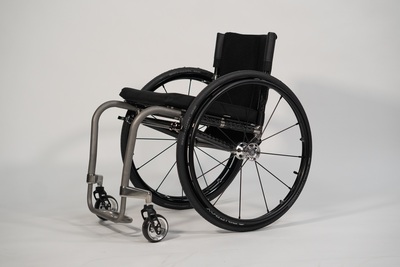Reinventing the wheelchair with advanced manufacturing

Australian manufacturer Rove Concepts has completed pre-production prototyping of a groundbreaking wheelchair that uses advanced materials such as 3D-printed titanium and carbon fibre to deliver comfort, weight savings and overall performance to wheelchair users.
The new design and manufacturing process offers elite athlete-style wheelchairs to the mass market in one-third of the time of traditionally manufactured units.
Supported by a $180,000 federal government grant administered by the Advanced Manufacturing Growth Centre (AMGC), the wheelchair is the result of a collaborative project involving Rove, wheelchair and assistive technology specialist Adaptive Concepts, Australian National University’s material testing and validation experts, and bespoke road bike maker Bastion Cycles.
“We aim to bring a high level of chair quality to the masses, rather than to just elite athletes,” Rove co-founder Ryan Tilley explained.

“Having the lightest set-up and ergonomics for a wheelchair from the outset is critical. Get it wrong and users will suffer from pressure sores, muscle pain and shoulder wear if the chair isn’t perfect,” added Keith Klein, Rove co-founder and father of a wheelchair user.
“Users push themselves around for as many as 12 hours a day, day after day, week, month, year and decade. If you can lighten the load, it’s an incredible benefit.”
Dr Jens Goennemann, Managing Director at AMGC, said, “Australian manufacturers like Rove are realising that ‘traditional’ sectors and products are ripe for disruption. Enabled by incredible design and engineering talent, Rove is setting a new standard in delivering to market an exceptional product and service — which can go global.
“In this case, Rove, collaborating with Bastion, has opened up a unique way of manufacturing wheelchair frames. Bringing them together has been a powerful thing. It is exciting to see Bastion’s knowledge of lightweight 3D-printed lugs, previously applied to bikes, find a place in a new product, and one with incredible promise.”
Using 3D-printed lugs, carbon fibre tubing and other aerospace materials, strength benefits and weight savings close to 4 kg per chair can be achieved — a vast improvement over traditional-type welded tube frames of steel or aluminium alloy.
The use of these techniques means that a customer can receive their wheelchair within four weeks, compared to the typical 12-week order cycle. Importantly, the rider will experience a much higher level of customisability and satisfaction.
“By changing the angle of lugs and the length of the tube, you can create a completely custom geometry,” Tilley explained.
“It is post-production customisable as well. The feedback from our users and our occupational therapists is that this is a massive boon.”
Psychologist training pathway review launched
To reduce workforce shortages while maintaining standards, a review of the way psychologists are...
Victoria to gain mental health workforce upskilling centre
From 1 July, the Victorian Collaborative Centre will become responsible for the professional...
Regional, rural and remote area doctors — have your say
Until 19 February, the Australian Medical Association is urging regional, rural and remote area...









